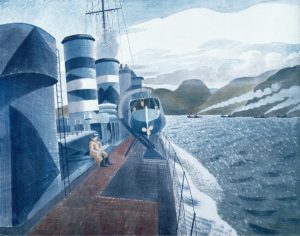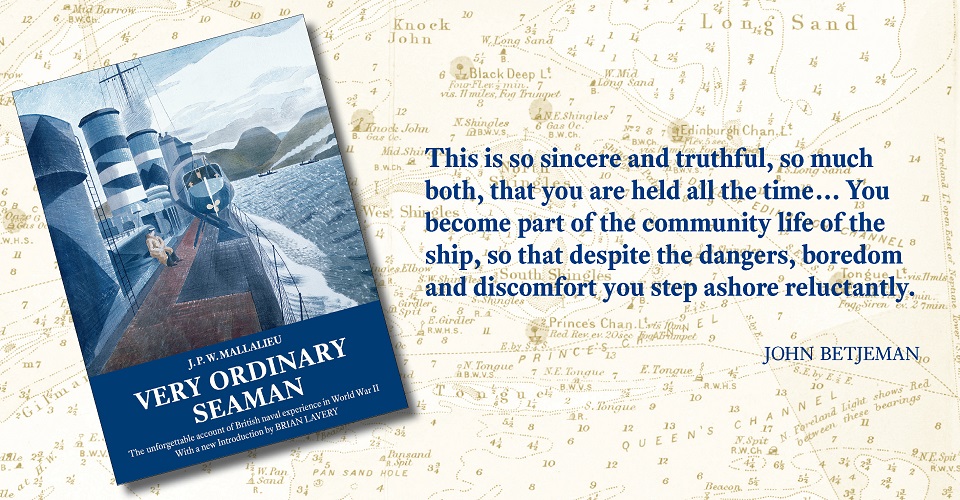 Most people reading this have enjoyed lives markedly more comfortable than those of their parents or grandparents. My own father served at sea when a teenager during World War II, as a stoker and coal trimmer on tramp steamers and later on deep-sea rescue tugs, on which he helped tow the Mulberry Harbours to Normandy for the D-Day landings. On St Patrick’s night, 17 March 1943, aged eighteen, he spent hours clinging to an upturned ship’s boat in the waters south of Greenland when the tramp steamer Kingsbury, in convoy to England, was torpedoed with much loss of life.
Most people reading this have enjoyed lives markedly more comfortable than those of their parents or grandparents. My own father served at sea when a teenager during World War II, as a stoker and coal trimmer on tramp steamers and later on deep-sea rescue tugs, on which he helped tow the Mulberry Harbours to Normandy for the D-Day landings. On St Patrick’s night, 17 March 1943, aged eighteen, he spent hours clinging to an upturned ship’s boat in the waters south of Greenland when the tramp steamer Kingsbury, in convoy to England, was torpedoed with much loss of life.
When I was eighteen the closest I came to his experience was reading Very Ordinary Seaman, J. P. W. Mallalieu‘s thinly novelised account of wartime life for the new naval rating, from basic training ashore to Arctic convoy duty. That book, written while the experience was fresh and the war still raged, staked a strong claim on my memory; I was surprised to find it out of print in recent years, and delighted when the late author’s family agreed to our new edition.
In a bid to avoid the conventional ‘bows-on in heavy seas’ cover picture I cast around for something different, and perhaps more thoughtful, and came across Leaving Scapa Flow by Eric Ravilious, whose work I have always found emotionally engaging; he depicts a destroyer much like the fictional HMS Marsden of the book.
Here is maritime historian Brian Lavery‘s Introduction to the new Lodestar Books edition of Very Ordinary Seaman:
When Very Ordinary Seaman first appeared in the spring of 1944, V. S. Pritchett of the New Statesman described it as ‘One of the best pieces of documentary writing that I have come across during the war.’ Elizabeth Bowen wrote in The Tatler, ‘the last chapters of Very Ordinary Seaman did leave me breathless; and also, feeling that we have known too little.’ John Betjeman wrote, ‘This is so sincere and truthful, so much both, that you are held all the time… You become part of the community life of the ship, so that despite the dangers, boredom and discomfort you step ashore reluctantly.’ By any standards this was a remarkable performance for a writer who was wearing the uniform of an ordinary seaman and sitting in a busy, overcrowded naval office ‘facing a blank wall and typing myself dry.’
Joseph Percival William Mallalieu (known as ‘Bill’ or ‘Curly’) was not without literary experience when he wrote the book. He was born in 1908, the son of a Liberal Member of Parliament, and educated at public school and Oxford University, where he became president of the Union. He travelled widely during the 1930s and worked as a journalist. He became a supporter of the Labour Party during the depression and he had already published two books before joining the navy. When the war began in 1939 he was sceptical about the aims of the Chamberlain government and registered as a conscientious objector. Then in 1940, ‘when Churchill formed the National Government with the full support of the Labour Party and when Germany smashed through Belgium, Holland and France and what remained of the British army escaped through Dunkirk; my own previous attitude to the war seemed irrelevant and possibly wrong-headed.’
The army was unpopular at this time, partly due to memories of the last war—practically everyone had a father, uncle or school teacher with stories of the horrors of the trenches. Military training at public schools did not always help, and Mallalieu was put off by it. ‘My memories of the Corps at Cheltenham were still vivid; so I was not going into the army.’ Moreover, the army had retreated at Dunkirk, in Greece and in Crete, and largely been saved by the navy. He decided to apply to the navy. At first the senior service turned him down, and it was 1942 before it was ready to receive him.
He joined on 23 February that year. He describes the arrival at the training base and his induction into the esoteric naval culture, the strange but iconic uniform, the vocabulary in which a shore base was one of His Majesty’s ships, floors were decks and leaving the base was ‘going ashore.’ As a mature and well-educated man, Mallalieu was naturally selected for the CW scheme, which was intended to produce officers (CW stood for the Commission and Warrant Branch of the Admiralty which administered it). Candidates would be chosen at the training bases and then sent to sea for at least three months as ordinary seamen before final selection. Most of them went to destroyers, the smallest ships commanded by regular navy captains, who could be trusted to apply proper standards in assessing them. They were also the most active and versatile ships in the fleet. Mallalieu’s group had warning of this under training, when the Chief Petty Officer told them, ‘… they’re putting most of you chaps in destroyers, and it’s a pretty rough life.’ Joseph Wellings, an American naval observer, wrote that ‘Destroyers are always on the go.’ And that did not take account of the extra hardships of the Russian convoys, which Mallalieu describes so graphically.
One thing the CW candidates noticed about the lower deck seamen was the great amount of swearing. Richard Wilson, another CW, wrote, ‘They peppered every sentence with obscenities, which they used so often that they became meaningless. A seagull was invariably a “fucking great shite ’awk”’. He came to regard the use of language as almost poetic. Mallalieu avoids censorship by using terms like ‘flicking’, ‘words which no seaman would deign to use, but which seem preferable to blanks.’ In a sense the swearing was part of the test. Only one of the CW candidates in John Whelan’s ship failed to be sent on to the next stage, and that was because he had become too closely integrated. A petty officer told him, ‘You forgot yer plum from Gieves. You’ve proved such a good lower deck seaman they won’t give you a commission.’ Despite that, as Mallalieu wrote, ‘At sea, at all times, there was much less consciousness of the distinction between officers and ratings than there is between managers and workers in a factory.’
It is not clear which destroyer Mallalieu served in. The drawing in the frontispiece of Very Ordinary Seaman is clearly of one of the ‘A to I’ classes built between 1928 and 1937 in annual batches of eight, each with names beginning with the appropriate letter of the alphabet. The ship shown has two funnels, four one-gun turrets and a rather light anti-aircraft armament. Originally the ships had two sets of quadruple torpedo tubes, but on most of them the after set was removed to fit a 3-inch anti-aircraft gun, which was captained by ‘Wild Angus’ in the fictional Marsden. HMS Forester, launched in 1933, has been suggested as the original on the grounds that she fought an action similar to the one described in the book. But it was a work of fiction and Mallalieu used the experiences of others, so that is far from conclusive.
The seamen of HMS Marsden clearly dreaded the Russian convoys, and for good reason. They began in August 1941, two months after Hitler’s invasion of the Soviet Union. They mostly sailed from western Scotland or Iceland and were routed round Norway towards the Russian ports of Murmansk and Archangel. Destroyers had been designed for service in the North Sea, English Channel and Mediterranean. Now they had to cope with extreme conditions, large waves and the cold, which might cover a ship in ice or snow which had to be cleared to prevent capsize. Atlantic convoys were horrific enough but only the U-boat was a real threat for most of the time. In the arctic, convoys might also be attacked by aircraft based in Norway, and there was a constant danger from surface ships including the mighty battleship Tirpitz. Winston Churchill described it as ‘The worst journey in the world.’
Mallalieu had probably finished his basic training by about April 1942, and he returned, ‘In the late Autumn of 1942, after some months in a destroyer on the seaways to Russia …’ which suggests that he could have served in convoys PQ15, PQ16 or PQ18—he was presumably not with the traumatic PQ17 which was dispersed with tragic consequences, and which led to the cycle being suspended after the return of PQ18. Most likely it was PQ16 which sailed from Iceland, as Marsden did. It consisted of 35 merchant ships and an auxiliary aircraft carrier with a close escort of five destroyers, an anti-aircraft ship, four corvettes, a minesweeper and four trawlers. It was supported by a group of cruisers and a more distant escort including a British and an American battleship and an aircraft carrier. The only destroyer in the close escort fitting the Marsden’s description was the A-class Achates, launched in 1929. The convoy sailed on 21 May to enter almost perpetual daylight in Arctic waters. That made U-boat action less likely as they preferred to attack on the surface at night; but raids by the Luftwaffe were a constant danger. During the voyage six merchant ships were sunk by air attack, one by U-boat and one by mine.
Mallalieu came back from sea service and was posted to the Royal Naval Barracks at Portsmouth, living in slum conditions as described, among others, by Alec Guinness as, ‘… the nadir of my lower-deck experiences where thousands of men slept, snored, or vomited—their hammocks slung three-deep in a cavernous tunnel which served as dormitory, bomb-shelter and lavatory.’ Mallalieu asked the training commander for permission to write a book on the navy. He was given ten day’s leave, and then,
When I got back I found that I had been appointed Commander’s Messenger which meant that for eight hours a day, five days a week, I sat in Commander Reid’s office, facing a blank wall and typing myself dry. There was no question of hanging about waiting for inspiration. There were no pauses for artistic temperament. I was under ‘naval discipline’. I wrote facing a blank wall and typing myself dry.
On reading the first draft Commander Reid felt that Mallalieu had not kept his promise to show the navy in a positive light, but he was soon converted. ‘Sorry. I’ve read it all again and think it’s fine.’ It is a measure of the book’s subtlety that it can be seen in several ways. Mallalieu was always slightly ambiguous about how much was fact, how much fiction. His publishers referred to it as a ‘novel’ and the Times Literary Supplement placed it at the top of its fiction list, but the author himself often called it his ‘book.’ He begins with the statement that ‘The main events round which this novel is written have really happened, though not necessarily to me and not necessarily in the manner or sequence in which they are here described.’ He also adds caveats about identifying real people among his characters, about swearing, and about wartime censorship—at one stage a destroyer fires blindly into a cloud of smoke and eventually hits an enemy ship, and one suspects that he was prevented from mentioning radar at this point. In other words, the book is not to be considered reliable on events or personalities, but there is every reason to believe it is a very accurate picture of lower deck life in a wartime destroyer. His publisher Gollancz agreed to take it provided it was cut from 130,000 to 80,000 words, perhaps to meet wartime paper restrictions. Unfortunately the complete draft does not seem to have survived. He was devastated by the first review in The Observer by Alan Pryce-Jones. He had ‘got bogged down in too much detail’ and the book lacked ‘imaginative fire’. But soon highly positive reviews began to appear in authoritative periodicals.
Very Ordinary Seaman was not alone in the wartime bookshops. One side-effect of the CW scheme was to expose the rich and exotic culture of the lower deck to a large number of articulate and well-educated people, and to produce a small but significant body of literature on the seaman’s life. John Davies produced Stone Frigate on basic training, and Lower Deck on destroyer life. Gorley Putt wrote Men Dressed as Seamen with illustrations by the great stage designer Roger Furse. Mallalieu’s Very Ordinary Seaman was by far the most successful. It sold 64,000 copies in hardback and remained in print for many years. Mallalieu’s friend Michael Foot considered it was ‘a masterpiece’ which would be read ‘as long as English seamen sail the seas.’
The CW scheme was changed not long after Mallalieu’s experience. There was no better test of character than three months on the lower deck of a wartime destroyer, but the problem was in assessing the results—a captain had far too much to do already without getting to know each candidate well, and mostly they passed them unless they had an obvious defect. As a result, failure rates in subsequent training at HMS King Alfred near Brighton were often as high as thirty percent. Specialised training ships were commissioned, based in the Firth of Forth, to test the CW candidates. Mallalieu himself failed to qualify as a sea officer due to sub-standard eyesight—‘although throughout my sea time just ended it had been good enough to let me act efficiently as a lookout on the bridge.’ Instead he went to King Alfred to qualify as a non-seagoing ‘green striper’ of the special branch of the Royal Naval Volunteer Reserve, and he wrote a manual for naval instructors. He became a Labour MP in the 1945 General Election and later served as Minister of Defence for the Navy, where he was noted for his sympathy for the lower deck.
It is a little surprising that a work of the brilliance of Very Ordinary Seaman is not better known today, but perhaps it falls between too many stools. It is a war story written by a left-wing socialist. It is not quite fact, not quite fiction. By necessity it is exclusively masculine. Its focus on the technicalities of destroyer operation is essential to understanding the story but is unfashionable with a certain type of modern reader and critic. As a ‘naval’ book it tends to appeal to a specialist market, though its insights on warfare and human nature are universal. It deserves to break out of the maritime ghetto and regain the more general readership of its earlier days.

